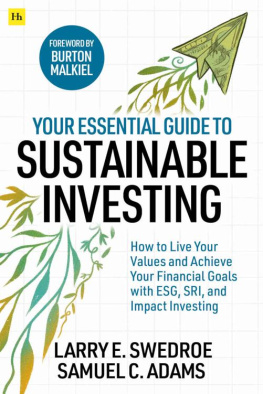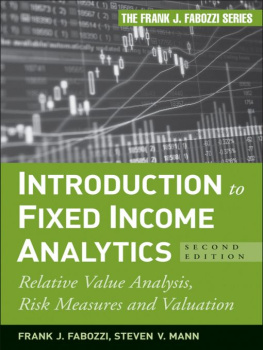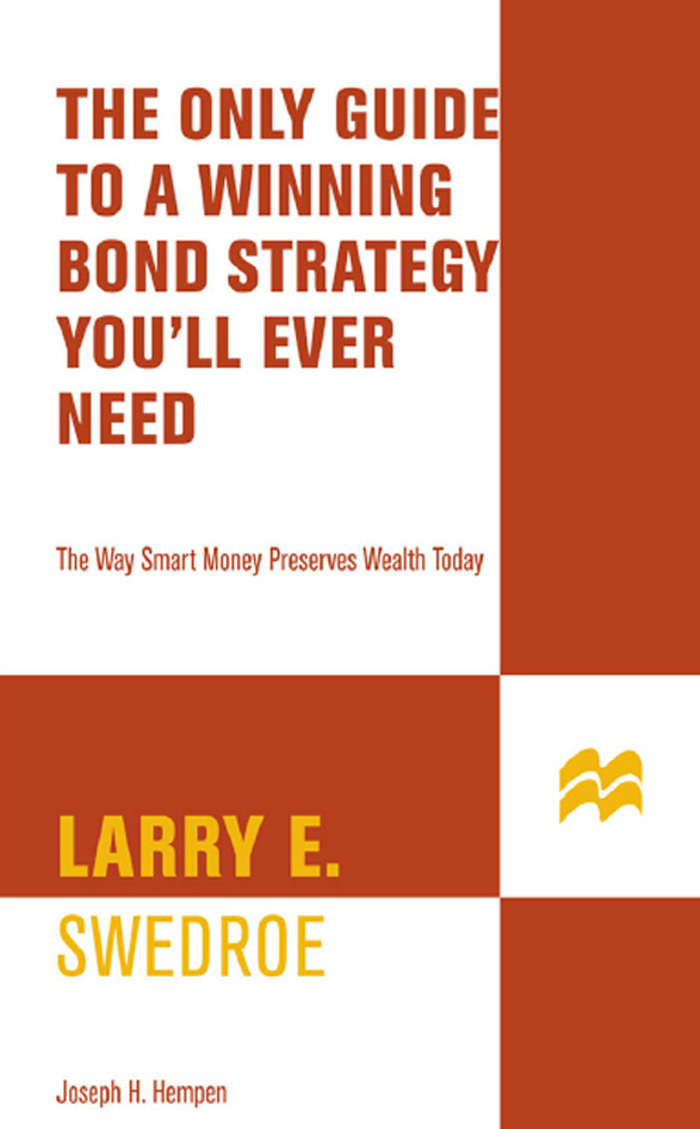THE ONLY GUIDE TO A WINNING BOND STRATEGY YOULL EVER NEED . Copyright 2006 by Larry E. Swedroe and Joseph H. Hempen. All rights reserved. Printed in the United States of America. No part of this book may be used or reproduced in any manner whatsoever without written permission except in the case of brief quotations embodied in critical articles or reviews. For information, address St. Martins Press, 175 Fifth Avenue, New York, N.Y. 10010.
www.stmartins.com
Library of Congress Cataloging-in-Publication Data
Swedroe, Larry E.
The only guide to a winning bond strategy youll ever need : the way smart money preserves wealth today / Larry E. Swedroe and Joseph H. Hempen,
p. cm.
A Truman Talley book.
ISBN 0-312-35363-4
EAN 978-0-312-35363-6
1. Bond. 2 Portfolio management. 3. Investments. I. Hempen, Joseph H. II. Title.
HG4651.S94 2005
332.63'23dc22
2005052949
10 9 8 7 6 5 4 3
THE
ONLY GUIDE
TO A
WINNING
BOND
STRATEGY
YOULL EVER NEED
Also by Larry E. Swedroe
The Only Guide to a Winning Investment Strategy Youll Ever Need
The Successful Investor Today
Rational Investing in Irrational Times
What Wall Street Doesnt Want You to Know
THE
ONLY GUIDE
TO A
WINNING
BOND
STRATEGY
YOULL EVER NEED
THE
ONLY GUIDE
TO A
WINNING
BOND
STRATEGY
YOULL EVER NEED
The Way Smart Money Preserves Wealth Today

LARRY E. SWEDROE
AND
JOSEPH H. HEMPEN


A T RUMAN T ALLEY B OOK
S T . M ARTINS P RESS  N EW Y ORK
N EW Y ORK
To the employees of Buckingham Asset Management,
BAM Advisor Services LLC, and the advisors at the more than
one hundred independent fee-only Registered Investment
Advisor firms with whom we have strategic alliances.
Each and every one of them works diligently every day
to educate their clients on how markets really work and on
the benefits of a prudent, long-term investment strategy.
The inconvenience of going from rich to poor is greater than most people can tolerate. Staying rich requires an entirely different approach from getting rich. It might be said that one gets rich by working hard and taking big risks, and that one stays rich by limiting risk and not spending too much.
Investment Management, edited by
Peter Bernstein and Aswath Damodaran
Introduction
Luck favors the prepared mind.
Louis Pasteur
If you dont profit from your mistakes, someone else will.
Yale Hirsch
D espite its obvious importance to every individual, our education system almost totally ignores the field of finance and investments. Therefore, unless you earn an MBA in finance you probably never were taught how financial economists believe the markets work and how you can best make them work for you. The result is that most Americans, having taken a course in English literature in high school, have more knowledge about William Shakespeare than they do about investing. Without a basic understanding of financial markets and how they work there is simply no way for individuals to know how to make prudent investment decisions.
Most investors think they know how markets work. Unfortunately, the reality is quite different. As humorist Josh Billings noted: It aint what a man dont know as makes him a fool, but what he does know as aint so. The result is that individuals are making investments without the basic knowledge required to understand the implications of their decisions. It is as if they took a trip to a place they have never been with neither a road map nor directions.
It is also unfortunate that many investors (and advisors) erroneously base their ideas and assumptions about fixed-income investing on their knowledge of equities. As you will learn, the two are completely different asset classes with different characteristics; even if the investors thought process is correct on the equity side it may not be correct in the case of fixed income. The result is that the investor often makes suboptimal decisions.
While education can be expensive, ignorance is generally far more costly, especially in the investment worlda world filled with hungry wolves waiting to devour the innocent sheep. Fred Schwed relates the following tale in his book Where Are the CustomersYachts? or a Good Hard Look at Wall Street. An outof-town visitor was being shown the wonders of the New York financial district. When his party arrived at the Battery, one of the guides indicated some handsome ships riding at anchor. He said, Look, those are the bankers and brokers yachts. The naive customer asked, Where are the customers yachts? The yachts of the investment bankers and brokers are paid for by the ignorance of investors.
Benjamin Franklin said, An investment in knowledge pays the best interest. Your investment in knowledge is the price of this book and the time you invest in reading it. The interest you receive will be the knowledge you need to be an informed fixed-income investor. Informed investors generally make far better investment decisions. And being an informed investor will help prevent you from being exploited by investment firms that take advantage of the lack of knowledge the general public has about fixed-income investing. The result is that it is more likely that you will be the one with the yacht, and not your broker.
When most investors begin their investment journey they focus on equity investing. Fixed-income investing is often an afterthought. This is unfortunate because for most individuals fixed-income investing plays an essential role in their overall investment strategy. Think of it this way, if your portfolio was a stew, fixed-income securities would be a main ingredient, like potatoes or carrots, not just a seasoning (e.g., salt, pepper) you add but might be able to leave out without adversely affecting the quality of the stew.
While there have been many books written on fixed-income investing, there have not been any that we are aware of that have met all of the following objectives:
- Educate you on the characteristics of all the types of fixed-income instruments available to investors, fully describing their risk and reward characteristics in plain and simple English.
- Address taxation and asset location issues (whether the asset is held in a taxable, tax deferred, or nontaxable account).
- Provide a practical road map to the winning strategy.
- Help you choose the most appropriate investment vehicles.
- Help you learn the best way to implement the winning strategy.
- Help you develop your own investment plan in the form of an investment policy statement (IPS).
The goals of this book are to meet all of these objectives and to convince you that while the world of fixed-income investing is a very complex one, the winning strategy is actually quite simple.
We begin with understanding that one of three motivations generally drive both individual and institutional investors to purchase fixed-income investments. The first is to provide liquidity to meet anticipated and unanticipated expenses. Any investments made for this reason should be highly liquid and should not be subject to any risk of loss of principal. Thus it belongs in such instruments as fully insured bank accounts, U.S. Treasury bills, and money-market mutual funds that invest in short-term instruments of the highest investment grade. This portion of your portfolio should really not even be considered an investment (which implies the taking of risk), but rather it is savings.








 N EW Y ORK
N EW Y ORK